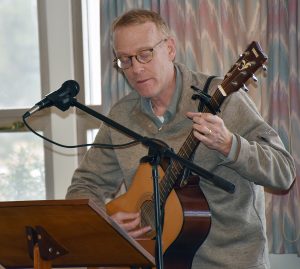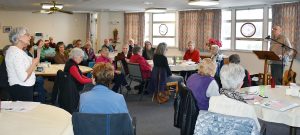Racial Justice and the Imagination’: Seeing Our Way in the Dark
Posted on March 1, 2018, by Mary Catherine Rabbitt SL

Photo courtesy of Mary Catherine Rabbitt
More than 50 Loretto Community members and friends gathered at the Loretto Center in Denver Jan. 27 to hear Christopher (Chris) Pramuk present a reflection on “Racial Justice and the Imagination.” Pramuk, a professor of theology at Regis University and a Merton scholar, is the author of several books, most notably Hope Sings, So Beautiful: Graced Encounters Across the Color Line (Liturgical Press, 2013), from which he drew most of his reflections.
Pramuk’s presentation included poetry, prose and song. He drew on three persons for his inspiration – Langston Hughes, Pope Francis and Bruce Springsteen. The songs were accompanied by Pramuk on his guitar. He immediately won over the audience when he began by reciting the last stanza of Cecily Jones ‘s 2005 poem, “The World Beyond Your Window” (dedicated to Mary Luke Tobin), which ends with “I bless the marigolds and barn you see as you embrace the world beyond your window.”
Pramuk spoke of walking deep into the woods one early morning on a former plantation in South Carolina, which is now the home of Trappist monks, Mepkin Abbey. He was there to give a lecture on Thomas Merton. Those woods contained an old slave cemetery with decrepit markers but with a lovely canopy of Resurrection moss on the trees. As he studied the grave markers, he was reminded of a phrase from Johann Metz: “dangerous memory.”
In 1988, Pramuk participated in a three-week workshop at the Naropa Institute in Boulder, Colo., on “The History of the Slave Songs,” led by Ysaye Barnwell of “Sweet Honey in the Rock.” This marked the beginning of a lifelong spiritual journey through sung prayer. He told us of the meaning behind the well-known spiritual, “Wade in the Water,” an anthem of the Underground Railroad – when you are escaping slavery, the dogs cannot follow your scent when you reach the water.
The next song he taught us was “Soon I Will Be Home, Going Home to Live With God.” He remarked that the spirituals were the soundtrack of the civil rights movement in the 1960s. He asked us to imagine these songs being sung in the dark, on the way home, under the stars, with every note marking a deliverance from the chains of slavery.
The first person he drew on was the poet Langston Hughes and his poem, “The Negro Speaks of Rivers.” Pramuk used Hughes’ poem to underscore “the beautiful connection to the land and the earth that saturates so many of the spirituals.” Pramuk also referenced abolitionist Frederick Douglass, who was born a slave and lived on a plantation in the South, separated by 12 miles from the plantation where his mother lived; she would walk those miles every night just to see her son. She died when Douglass was just 7 years old; his remembrances of her are somewhat vague. “I never saw her in the light of day,” yet, as Pramuk remarked, “her love for him was embedded in his flesh.”
Pramuk also spoke of taking inspiration from Pope Francis, through his encyclical on the environment, Laudato Si’. Francis draws on the mother imagery of sister/mother earth: “Earth’s suffering is a MIRROR of our own violence by our irresponsible use and abuse of what God has endowed us with.” Pramuk remarked that the murders of the nine people in a Charleston church occurred the night before Laudato Si’ was published. He also connected the sentiments in the encyclical with that famous phrase from Dr. Martin Luther King Jr., “an inescapable network of mutuality.”

Photo courtesy of Mary Catherine Rabbitt
Between these reflections, Pramuk wove his own personal spiritual journey and that of his family. He and his wife, Lauri, adopted two children from a Haitian orphanage shortly after the devastating earthquake that struck Haiti in 2010. He shared several anecdotes from his son, Henry (now 8), who, on the day following the election of Donald Trump, remarked, “Trump wants to erase brown/black people from the U.S.”
Pramuk’s third and final inspiration came from Bruce Springsteen, particularly from his 1991 song “American Skin” (aka: “41 Shots”), which contains a haunting refrain about the “41 shots” fired by New York Police at Guinean immigrant Amadou Diallo. In it, Springsteen sings, “You can get killed just for living in your American skin.” In Springsteen’s autobiography, Born to Run, he shared that this song is the only one for which he has ever received significant pushback.
Pat McCormick, the organizer for this workshop, hopes it will be the first of many. When asked about her motivation, Pat said, “I want us in the Community to have these conversations about how we engage in what Chris calls an ‘internal racial resistance.’ Not conversations about the past but the now – that we are that America that stands on the sidelines while black and brown kids get murdered … kids asking their parents about being erased from this country. Not that we have answers but, as one black female author asked, ‘When was the last time you had a conversation about race with your white friends?’ Not about what is happening to ‘them’ but about what is happening to ‘us,’ the benefactors of excluding others, of separateness, of someone ‘staying in their place.'”
I think that Pramuk’s workshop was a good push in the right direction for us in Loretto to have those conversations. No one in the room wanted the session to end. It was a remarkable experience, or, as reflected in the sub-title of Pramuk’s book, Hope Sings, So Beautiful, a graced encounter across the color line. May it be a new beginning.
